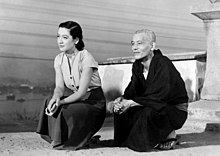Setsuko Hara
Hara Setsuko ( Japanese 原 節 子 Hara Setsuko , real name 会 田 昌江 Aida Masae ; born June 17, 1920 in Yokohama , Japan ; † September 5, 2015 in Kanagawa Prefecture ) was a Japanese actress , who was mainly known through her collaboration with Yasujiro Ozu became known.
Life
Setsuko Hara came into the movie business when she was fourteen when her brother-in-law, director Hisatora Kumatani, encouraged her to audition at the Nikkatsu film studio . She was immediately hired for a leading role in the love story Tamerau nakare wakodo yo . The breakthrough for Hara came when the German director Arnold Fanck discovered her and gave her the lead role in the German-Japanese coproduction The Daughter of the Samurai in 1936 . During World War II , Hara became the most popular actress in Japan. After the end of the war, her most successful period began when she worked with the directors Akira Kurosawa (as in the Dostoevsky film The Idiot 1951), Mikio Naruse and Yasujiro Ozu.
Setsuko Hara is one of the symbolic characters for the golden age of Japanese cinema in the 1950s. Her nickname was The Eternal Virgin (she remained unmarried even in real life) and she was the epitome of the Yamato nadeshiko female type, popular during World War II . Especially her work with Ozu is still remembered today; she appeared in six of his films, including the Noriko trilogy with the films Late Spring ( Banshun , 1949), Wheat Autumn ( Bakushū , 1951) and The Trip to Tokyo ( Tokyo monogatari , 1953). In each of these three films, Hara played characters named Noriko , who are each different characters, but all share their trait as single women in post-war Japan. The trip to Tokyo is considered by many to be their best and most famous film. During this time, however, Hara was repeatedly forced to take longer breaks due to illnesses, whereby the accidental death of her brother also burdened her. Her last film with Yasujiro Ozu was the autumn of Kohayagawa family ( Kohayagawa-ke no aki , 1961), Ozu's penultimate film before his death in 1,963th
Shortly after Ozu's death, Setsuko Hara completely retired from acting. It is not clear whether Ozu's death or her own health was responsible for this withdrawal. Since then, Hara has lived in the Japanese coastal city of Kamakura , which is also home to Ozu's grave. The extremely withdrawn actress declined all public appearances. Presumably this sudden end to her career contributed to her legendary fame. Hara's life is considered a role model for Satoshi Kon's animated film Millennium Actress . She died of pneumonia on September 5, 2015 at the age of 95, but her death was not announced until more than two months later.
Filmography (selection)
- 1935: Tamerau nakare wakodo yo ( Don't Hesitate, Young Folks ) - director: Tetsu Taguchi
- 1937: The Samurai's Daughter (Atarashiki tsuchi) - directed by Arnold Fanck and Mansaku Itami
- 1942: The Battle of Hawaii and the Malay Sea (Hawai marē oki kaisen) - Director: Kajirō Yamamoto
- 1946: No Regrets for My Youth (Waga Seishun ni Kuinashi) - Director: Akira Kurosawa
- 1949: Late Spring (Banshun) - Director: Yasujirō Ozu
- 1951: The Idiot (Hakuchi) - Director: Akira Kurosawa
- 1951: Wheat Autumn (Bakushū) - Director: Yasujirō Ozu
- 1953: The Journey to Tokyo (Tōkyō monogatari) - Director: Yasujirō Ozu
- 1954: Berggrollen (Yama no oto) - Director: Mikio Naruse
- 1956: Shu-u (English: Sudden Rain ) - Director: Mikio Naruse
- 1957: Tokyo at Dusk (Tōkyō boshoku) - Director: Yasujirō Ozu
- 1960: Like a stone by the wayside (Robo no ishi) - Director: Seiji Hisamatsu
- 1960: Late Autumn (Akibiyori) - Director: Yasujirō Ozu
- 1961: The Autumn of the Kohayagawa Family (Kohayagawa-ke no aki) - Director: Yasujirō Ozu
- 1961: Chūshingura - Director: Hiroshi Inagaki
Web links
- Setsuko Hara in the Internet Movie Database (English)
- Biography of Setsuko Hara ( Memento from May 26, 2008 in the Internet Archive )
Individual evidence
- ↑ Her eroticism was that of inaccessibility. In: welt.de. Die Welt , November 25, 2015, accessed on November 27, 2015.
- ↑ Dave Kehr : New Contender for the Anime Throne. In: The New York Times , Jan. 11, 2004; accessed on December 16, 2009.
- ↑ Obituary in the Asian Review ( memento of the original from November 25, 2015 in the Internet Archive ) Info: The archive link was inserted automatically and has not yet been checked. Please check the original and archive link according to the instructions and then remove this notice.
- ↑ Andreas Kilb : Tragedy of a Smile . In Frankfurter Allgemeine Zeitung of November 28, 2015, p. 16
| personal data | |
|---|---|
| SURNAME | Hara, Setsuko |
| ALTERNATIVE NAMES | Hara Setsuko, 原 節 子 (Japanese); Aida Masae (real name); 会 田昌江 (real name, Japanese) |
| BRIEF DESCRIPTION | Japanese film actress |
| DATE OF BIRTH | June 17, 1920 |
| PLACE OF BIRTH | Yokohama , Japan |
| DATE OF DEATH | 5th September 2015 |
| Place of death | Kanagawa Prefecture |

